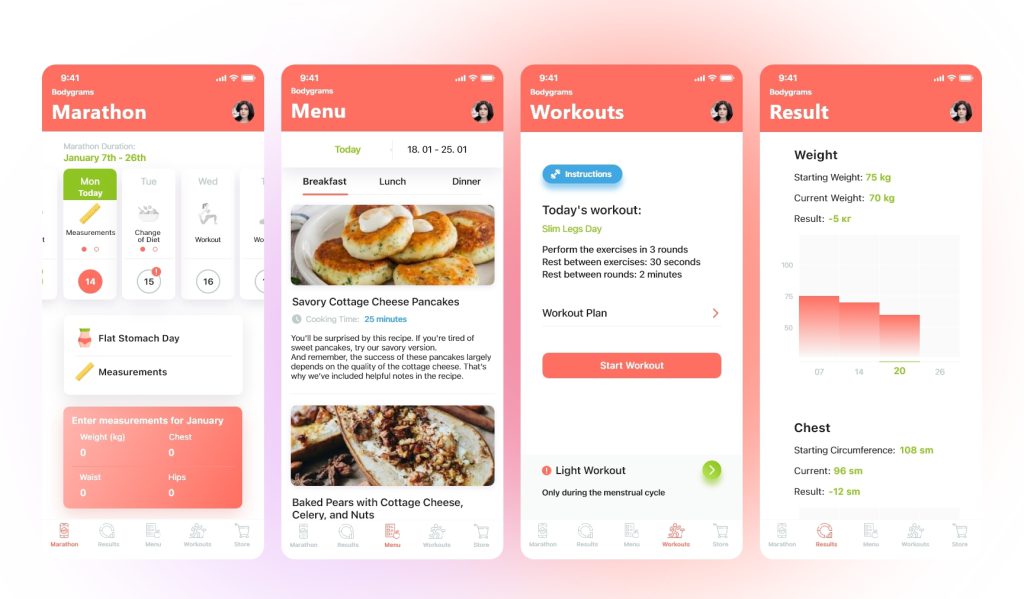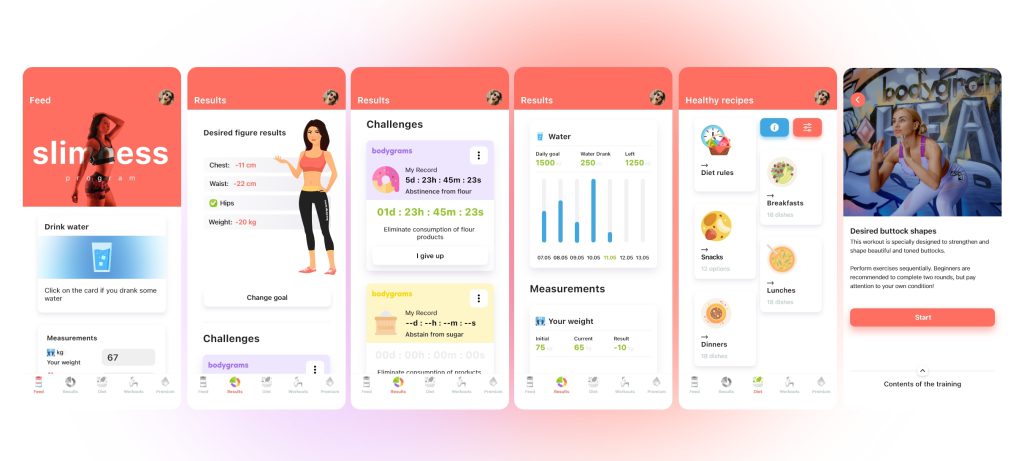Bodygrams is not just a mobile app for a healthy lifestyle—it’s the result of a long journey that began when healthy living was just starting to gain traction locally, while it had already become a trend abroad. We saw the growing demand for wellness and decided to create a convenient solution that brought all the essential tools for achieving fitness goals into one platform
At the start, Bodygrams was envisioned as a website where users could participate in weight-loss marathons by following provided meal plans and workouts while tracking their results. However, we quickly realized that a mobile app would be more convenient for users, who preferred having a tool readily available on their phones.
Thus, in 2019, the first version of the Bodygrams app was launched. This was our first step in creating a full-fledged fitness platform where users could not only follow structured plans but also take full control of their journey toward health and wellness.

The first version of the app included five main sections:
For content management, WordPress was initially used, but at some point, it became clear that it couldn’t support the growing functionality needs of the app.

One of the most labor-intensive parts of creating Bodygrams was filming the workout videos. We knew that high-quality video content was crucial to the app’s success. For this, we had to assemble a team: a videographer, an editor, and a scriptwriter. We rented a studio, set it up to resemble a home workout environment, and hired a professional fitness trainer, who not only developed the workout plan but also acted as the model in 60 videos—30 unique 30-minute workouts and 30 lighter 15-minute versions.
During the filming process, we decided to supplement the app with useful educational content, such as a guide to proper nutrition and workout instructions. This made the app not only functional but also informative.
Once everything was ready, we eagerly awaited the app’s release on Google Play and the App Store. However, as often happens, things didn’t go smoothly: Apple initially rejected our build, requesting scientific references for the proposed diet plans. After adding the necessary references, both the iOS and Android versions of the app became available for download.
To promote the app, we decided to buy ads in app stores and experiment with generating traffic from TikTok. We hired a blogger to create short videos promoting a healthy lifestyle and our app. While we expected gradual growth, one day our servers crashed due to an overwhelming surge in users—one of the TikTok videos went viral, bringing in about 15,000 users within an hour. This happened during the COVID-19 pandemic when many were looking for ways to exercise at home, making Bodygrams an ideal solution for them. By the end of 2020, we had around 40,000 users.
The first version of Bodygrams was successful, but it was essentially an MVP (minimum viable product). We knew that to continue growing and retaining users, we needed to remove technical limitations and offer more useful features. Thus began the development of the second version, which became a breakthrough in the app’s evolution.
One of the first steps was to abandon WordPress as the content management system. It no longer met the functionality demands of the app, so we built a custom admin panel from scratch. This allowed us to better manage content and implement new monetization strategies.

In the second version of Bodygrams, we focused on flexible monetization through a Premium subscription model. We also introduced a free workout and meal plan program to attract a broad user base, with the aim of converting them into paid subscribers. Here are some of the key changes and new features in the second version:

Today, Bodygrams has a global audience, which continues to grow. We strive to consider the needs of users from different countries and constantly evolve the app by adding new features and improving existing ones.
We see significant potential in expanding into new markets and are exploring the possibility of integrating with other popular platforms for tracking physical activity and health. In the future, we plan to add more languages, new workout and nutrition programs, as well as even more advanced data analysis and personalization tools for users.
Bodygrams is not just an app for healthy living—it’s the result of years of hard work, market analysis, and continuous improvement. What started as a simple idea for a weight-loss marathon website has grown into a powerful platform that helps thousands of users worldwide achieve their health and fitness goals. And we’re not stopping here. New challenges and greater opportunities lie ahead, which we’re excited to bring to our users.
You can download the Bodygrams app on both Google Play and the App Store to start your fitness journey today.